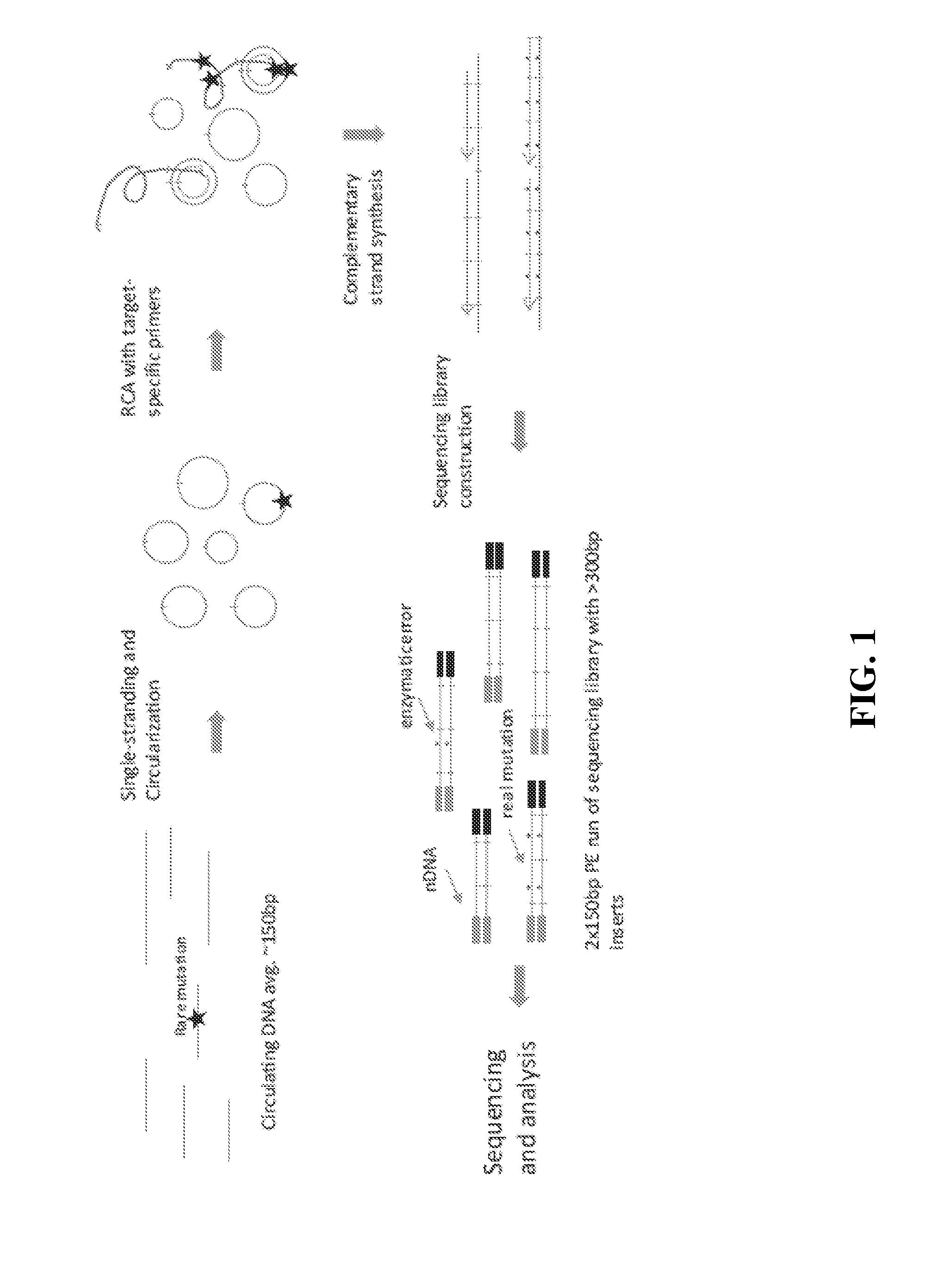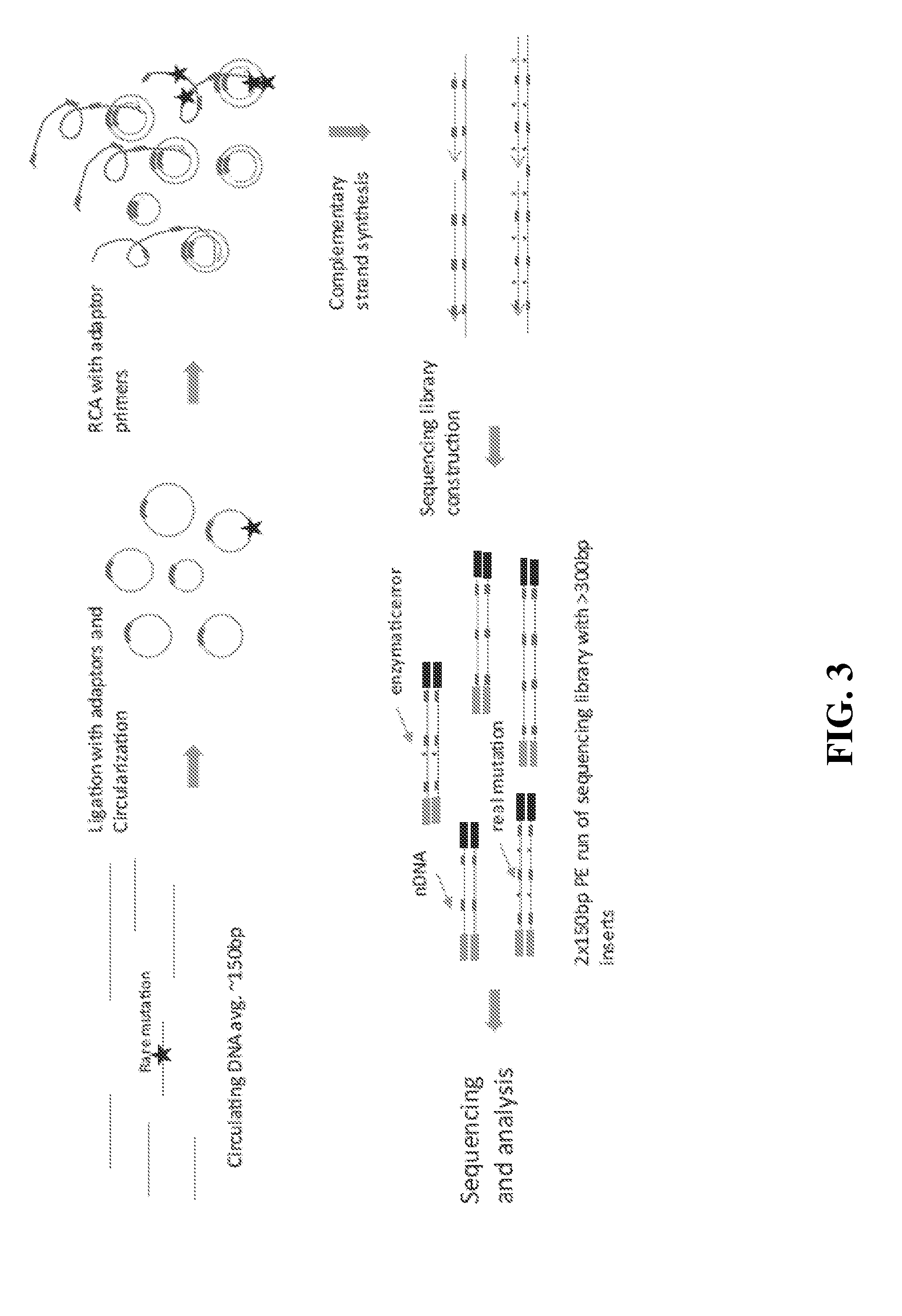Compositions and methods for detecting rare sequence variants
a rare sequence variant and sequence technology, applied in the field of rare sequence variant composition and method, can solve the problems of large-scale parallel sequencing with significant limitations, high false positive rate of rare sequence variant detection, and large error frequency of common-used techniques
- Summary
- Abstract
- Description
- Claims
- Application Information
AI Technical Summary
Benefits of technology
Problems solved by technology
Method used
Image
Examples
example 1
Preparing Tandem Repetitive Sequencing Library for Mutation Detection
[0155]Starting with >10 ng of ˜150 bp DNA fragments in 12 μL water or 10 mM Tris-HCl pH 8.0, 2 μL 10× CircLigase buffer mix was added and mixture heated to 95° C. for 2 minutes and chilled on ice for 5 minutes. To this was added 4 μL 5M Betaine, 1 μL 50 mM MnCl2, and 1 μL CircLigase II. The reaction was incubated at 60° C. for at least 12 hours. Next was added 2 μL RCA primer mix (50 nM each, to a 5 nM final concentration), and mixed. The mexture was heated to 95° C. for 2 minutes and cooled down to 42° C. for 2 hours. The CirLigation product was purified with Zymo oligo nucleotide purification kit. According to the manufacturer's instructions, 28 μL water was added into 22 μL CircLigation product for a total volume of 50 μL. This was mixed with 100 μL Oligo binding buffer and 400 μL ethanol. This was spun for 30 seconds at >10,000×g, and the flow-through was discarded. 750 μL DNA wash buffer was added, then spun f...
example 2
Making Tandem Repetitive Sequencing Library for Detection of Sequence Variants
[0159]10 ng of DNA fragments with 150 bp average length in a 12 μL volume were used for tandem repetitive sequencing library construction. The DNA was previously processed with T4 Polynucleotide Kinase (New England Biolabs) to add phosphate group at the 5′ terminus and leaving a hydroxyl group at the 3′ terminus. For DNA fragments generated from DNase I or enzymatic fragmentation or extracted from serum or plasma, the terminus processing step was skipped. The DNA was mixed with 2 μL 10× CircLigase buffer (Epicentre CL9021K). The mixture was heated to 95° C. for 2 minutes and chilled on ice for 5 minutes, then 4 μL Betaine, 1 μL 50 mM MnCl2, and 1 μL CircLigase II (Epicentre CL9021K) were added. The ligation reaction was performed at 60° C. for at least 12 hours. 1 μL of each RCA primer mix at 200 nM (to final of 10 nM final concentration) was added to the ligation products and mixed, heated to 96° C. for 1...
example 3
Fragmentation of Genomic DNA for Sequencing Library Construction
[0167]1 μL of genomic DNA was processed using a NEBNext dsDNA Fragmentase kit (New England Biolabs) by following the manufacturer's protocol. Incubation time was extended to 45 minutes at 37° C. The fragmentation reaction was stopped by adding 5 μL of 0.5M EDTA pH 8.0, and was purified by adding 2× volumes of Ampure XP beads (Beckman Coulter, A63881) according to the manufacturer's protocol. Fragmented DNA was analyzed on a Bioanalyzer with a High Sensitivity DNA kit (Agilent). The size range of fragmented DNA was typically from about 100 bp to about 200 bp with a peak of about 150 bp.
PUM
| Property | Measurement | Unit |
|---|---|---|
| mass fraction | aaaaa | aaaaa |
| mass fraction | aaaaa | aaaaa |
| mass fraction | aaaaa | aaaaa |
Abstract
Description
Claims
Application Information
 Login to View More
Login to View More - R&D
- Intellectual Property
- Life Sciences
- Materials
- Tech Scout
- Unparalleled Data Quality
- Higher Quality Content
- 60% Fewer Hallucinations
Browse by: Latest US Patents, China's latest patents, Technical Efficacy Thesaurus, Application Domain, Technology Topic, Popular Technical Reports.
© 2025 PatSnap. All rights reserved.Legal|Privacy policy|Modern Slavery Act Transparency Statement|Sitemap|About US| Contact US: help@patsnap.com



